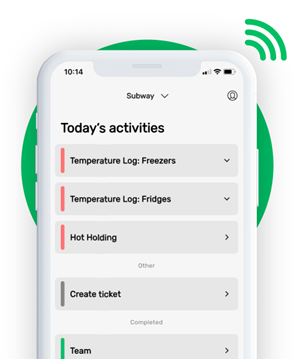HOW LONG TO KEEP LEFTOVERS CHART
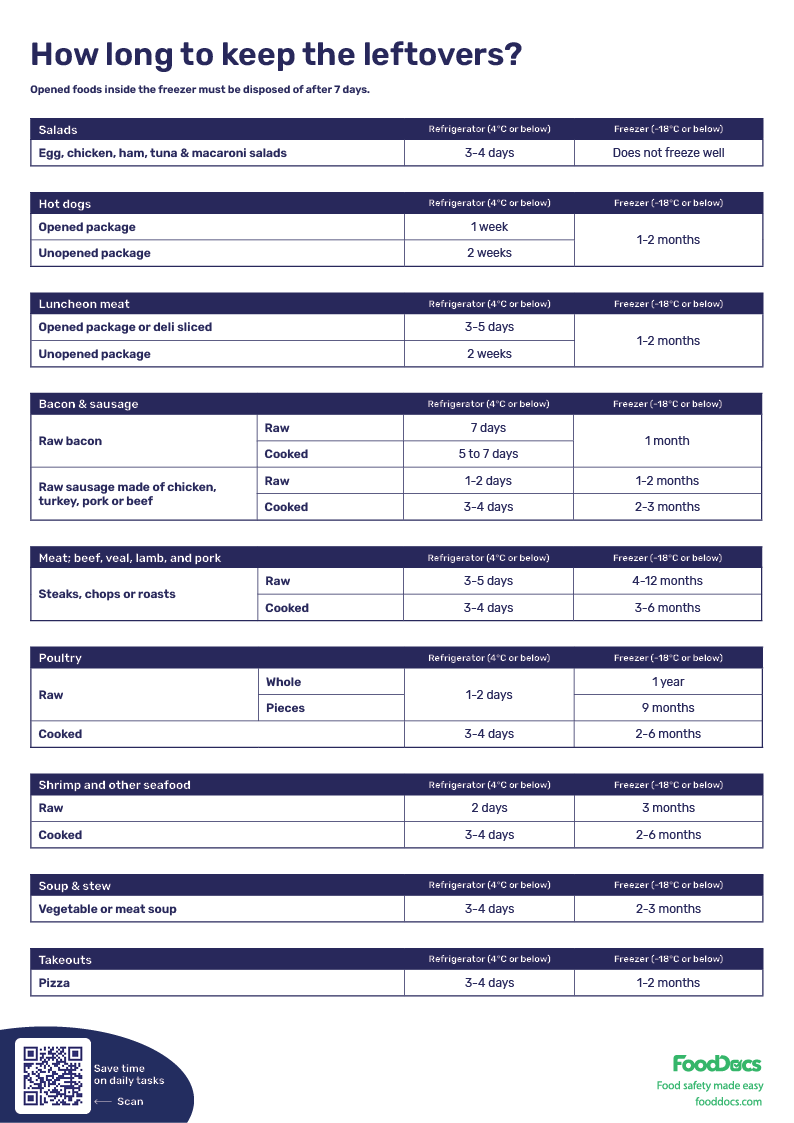

This is how our Digital Food Safety platform saves 20% of your time on daily tasks:
- Get upcoming task notifications
- Add data into the app
- Check the status of tasks in real-time

When food safety was still handled on paper, I typically spent a couple of hours per day getting the papers and going around checking or completing tasks… Now I can sit down and it's just all there in one place. It takes me 5-10 minutes.
Ruth B.
Store Manager
How long to keep leftovers chart
Proper handling of leftovers is an essential part of food safety principles. Leftovers may refer to prepared, excess food items that may still be used or the next preparation. When handled and stored correctly, these food ingredients can still be safely used and optimized without the risk of food poisoning. Food business owners will significantly benefit from educating their employees using our How Long to Keep Leftovers Chart.
Increase your revenue by ensuring that every last piece of refrigerated leftovers and product in your kitchen is used as intended by ensuring proper food storage. Learn how you can train and guide your employees in handling leftovers from this article and implement our smart Food Safety Management System at FoodDocs for more efficient food safety compliance.
What is the How Long to Keep Leftovers Chart?
The How Long to Keep Leftovers Chart is a reference poster that indicates the recommended maximum shelf-life of different foods in the fridge or freezer, as recommended by federal agencies. It is an informative tool that can be used by different food businesses to guide food handlers with the maximum shelf-life of refrigerated foods.
All foods, whether fresh, cooked, or preserved, have their maximum shelf-life. The recommended optimum time of storage is significantly affected by factors such as time, temperature, and sanitation of the environment. Food shelf-life can be prolonged by storing them properly.
In the case of leftovers, their shelf-life can further be extended only if they are handled correctly and processed at the proper temperature for cooking food.
Ideally, high-risk foods or those rich in nutrients and moisture have a shorter shelf-life than shelf-stable foods. The latter type of food includes dried products, uncooked rice, and canned foods.
Examples of high-risk foods include the following:
- meat
- poultry
- egg and egg products
- milk and dairy products
- vegetables and fresh fruit
These food products are also known as TCS foods or time/temperature control for safety food groups as they require close controls to maintain safety. Such rules for food safety are essential for compliance and protecting public health.
Learn more about how to handle leftovers properly and how long can they be kept in the fridge in our detailed article here.
Complement this food safety poster with our Cold Food Storage Chart, which shows you the rules on how to keep cold food cold properly.
How long can leftovers last in the fridge?
Leftovers are safe for consumption for up to 3 to 4 days in the refrigerator. If placed in the freezer, leftovers can stay safe for up to 3 to 4 months. This recommendation is based on scientific studies and the guidelines released by federal agencies, including the U.S. Department of Agriculture Food Safety and Inspection Service. This recommended storage shelf-life for cooked leftovers only considers the safety of foods and does not include their quality.
Lengthy freezer storage can lead to a loss of quality over time. Leftovers, in particular, require strict handling measures as they have been previously exposed to food hazards.
The general rule for extending the shelf-life of common foods is to keep them away from the temperature danger zone, which is 5°C to 60°C.
When food handlers properly store food according to the recommended conditions, they can optimize their use and prevent unnecessary food waste. Operations such as storing them in shallow containers or covering the storage containers with plastic wrap are major factors in prolonging food shelf-life.
How long can you keep boiled eggs in the refrigerator?
Boiled eggs can last for up to 7 days in the refrigerator after being cooked. This estimated shelf-life applies to both peeled and boiled eggs in shells. When frozen, boiled eggs can last for up to a year.
Eggs normally have a long shelf life when refrigerated. Refrigerated fresh eggs can last up to 3 to 5 weeks.
Eggs and egg products are generally considered high-risk foods. This means that they are likely to be contaminated and spoiled when handled incorrectly.
How long can you keep cooked meat in the refrigerator?
Cooked meats can stay fresh and safe for consumption in the refrigerator for 4 days. Beyond this estimated shelf-life, the cooked meat product may lose its quality (e.g., flavor and texture) and become more prone to food contamination and spoilage. Frozen meat shelf-life can be extended for up to 3-6 months, depending on the freshness of the product before freezing.
This estimated product shelf life applies to meat, such as pork, beef, veal, and mutton, and meat products, such as steaks.
Cooked ground meat can last for up to 4 days in the refrigerator and only 4 months in the freezer.
On the other hand, processed meats, including bacon and sausages, have a slightly shorter shelf-life. Cooked slices of bacon can last up to 7 days in the fridge but only up to a month in the freezer. In the case of sausages, refrigerating cooked sausages can extend their shelf-life to a maximum of 4 days and only 3 months in the freezer.
How long can you keep cooked shrimp in the refrigerator?
Cooked shrimp and other seafood, when refrigerated, can stay fresh and safe for consumption for up to 4 days. You can further extend their shelf-life to 2 to 6 months if you freeze them.
The majority of seafood cannot stay for too long in the freezer. Because of the type of meat that they have, freezing them for too long can change their texture easily.
How long can you keep cooked chicken in the fridge?
Food handlers can store cooked chicken inside the fridge for up to 3 to 4 days. This applies to both whole chickens and pieces of poultry meat. This estimated shelf-life can only be achieved if the cooked poultry meat is handled correctly.
Improper handling of poultry meat can lead to early spoilage, which is often a cause of foodborne illnesses. Poultry meat must be cooked to an internal temperature of 74°C to maintain food safety.
How long does rice last in the fridge?
Cooked rice can last for up to a maximum of 4 days in the fridge. A day more than this recommended storage shelf-life can significantly increase, causing foodborne illness. Cooked rice can only be frozen for 1 month.
If possible, food handlers are discouraged from refrigerating cooked rice as it can easily be contaminated. Rice is a carbohydrate-rich food; therefore, it is considered high-risk. Leaving cooked rice unattended in the temperature danger zone for more than 2 hours can potentially cause foodborne illness.
How long can you keep sushi in the fridge?
Sushi is a complex meal made up of different ingredients. It can have seafood and vegetables mixed in with the rice. This nature of sushi makes it very prone to spoilage and can only last a couple of days in the refrigerator. At a maximum, sushi can stay safe and fresh for consumption in the freezer for 1 to 2 days.
Keep track of all of your ingredient and product shelf-life with our smart Food Safety Management System at FoodDocs. Our smart software features a Traceability System that can give you a simple overview of your product shelf-life status. This system comes with a smart notification feature that will alert food handlers whenever a product is near its expiration date.
Who needs to monitor how long leftovers can last in the fridge?
Food businesses, including food service, retail, and manufacturing, need the How Long to Keep Leftovers Chart as a guide. This tool will help food handlers always stay on top of managing their raw ingredients. The chart can be an essential part of every food business' traceability system and teach food employees to handle leftovers with care.
Food service and food manufacturing businesses can use this chart to control storing leftovers and maximize their potential use. On the other hand, retailers can use the shelf-life information on the chart about refrigerating raw materials.
Why is it important to monitor the shelf-life of foods?
It is part of every food business' task to monitor the shelf-life of their products, both leftovers and raw food ingredients. This is an integral operation for maintaining food safety.
- Food safety. The shelf-life of food directly affects its safety. Food business teams that have efficient control of their product's shelf life can minimize the risk of causing foodborne illness.
- Optimize the use of products. When businesses monitor the shelf-life of their products and understand food storage rules, they can strategize which batches to use first and prevent raw materials from spoiling. In case foods spoil, they can ensure that food handlers will no longer use them for food preparation.
This benefit not only leads to increased profit gains but also to less food wastage. Your business can become more sustainable by optimizing every food ingredient.
- Increased consumer confidence. Control over your product's shelf-life shows your commitment to food safety and protecting public health. Your approach to food safety can help your brand gain more attention and confidence from consumers.
What are the benefits of the How Long to Keep Leftovers Chart?
Monitoring the shelf-life of your food ingredients and products is a constant task to maintain food safety. Food handlers with good control of their food shelf-life can improve operations and increase revenue gains.
Food businesses can achieve these objectives by using the How Long to Keep Leftovers Chart. Specifically, this tool provides the following benefits:
- Reminder. This chart, when placed in a visible location for food handlers, can serve as a reminder for highly perishable foods. Employees can use it as well to determine if a food ingredient is still safe to be used for a dish.
- Employee training. The chart can be used for onboarding new employees. It can be used to introduce the importance of food shelf-life and which conditions will favor longer storage safety.
- Cost saving. When employees have an efficient way to track food shelf-life, your team can ensure that every ingredient will serve its intended purpose. This benefit can help you reduce food wastage and optimize revenues.
- Food safety compliance. Keeping foods in proper storage is an important food safety regulation. All foods must be protected from unfavorable conditions. Using this chart can help you consistently maintain compliance.
Our How Long to Keep Leftovers Chart is just one of our many free food safety tools. Visit our template hub and get more free checklists, templates, and charts to help your team comply with food safety regulations.
How to use the free chart?
To make the most of our free How Long to Keep Leftovers Chart, follow these steps:
1. Download the chart from above by entering your email and hitting "download."
2. Find the downloaded full-quality file from your downloads folder. Print the chart.
3. Attach the chart to the wall of your kitchen and/or other working areas where food workers can clearly see it. We recommend putting this chart on the door of a refrigerator.
4. Briefly explain the idea of the chart and summarize the importance of shelf-life to your employees.
5. Be always up to date with our new free templates, tools, and charts from our template hub and through the newsletter that we will send you once a month to introduce our new content.
How to help my team monitor the shelf-life of foods?
Handling leftovers and food safety go hand in hand. Businesses that can optimize their use of leftovers can fully use the potential of their food products. With the idea of using leftover ingredients, food handlers must also be aware of how perishable they can be. Employees must be properly trained on how to handle refrigerated and frozen leftovers.
Different ingredients may have a different maximum shelf life and peak quality. As such, employees must be aware of the product's individual storage lives. With the other tasks in a food business, this job may be too tedious and hard to keep up with.
To help you keep track of foods at a safe temperature, use FoodDocs' smart Food Safety Management System.Food handlers can simultaneously perform multiple food safety tasks and never forget one using our smart software.
Achieve these objectives using the following benefits from our software:
- Monitor the shelf-life of your products and ingredients intuitively using our Traceability System. With this feature, our system can automatically compute a product's shelf-life based on the information you enter. Employees will then get notified whenever a product is nearing its expiry date. With this feature, you can optimize all of your food ingredients.
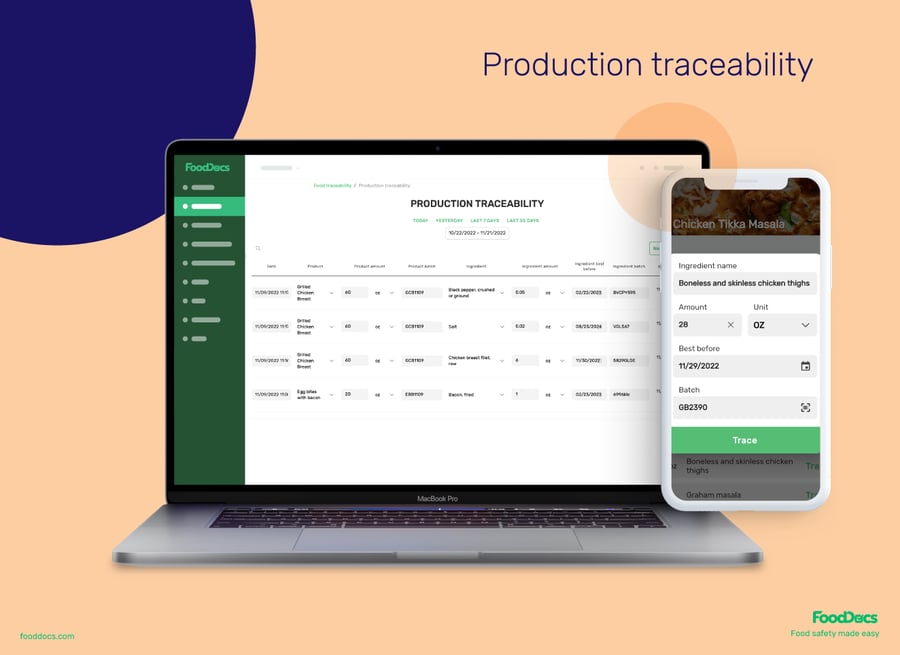
Production Traceability System from FoodDocs
- Our Traceability System can also help you track the movement of your materials within the food supply chain.
- Get automatically generated monitoring logs for all of your food-handling tasks. Use these logs to ensure that foods are properly prepared so that leftovers will remain safe even at refrigeration. Our system can generate the following monitoring logs for you:
- Cooking temperature log
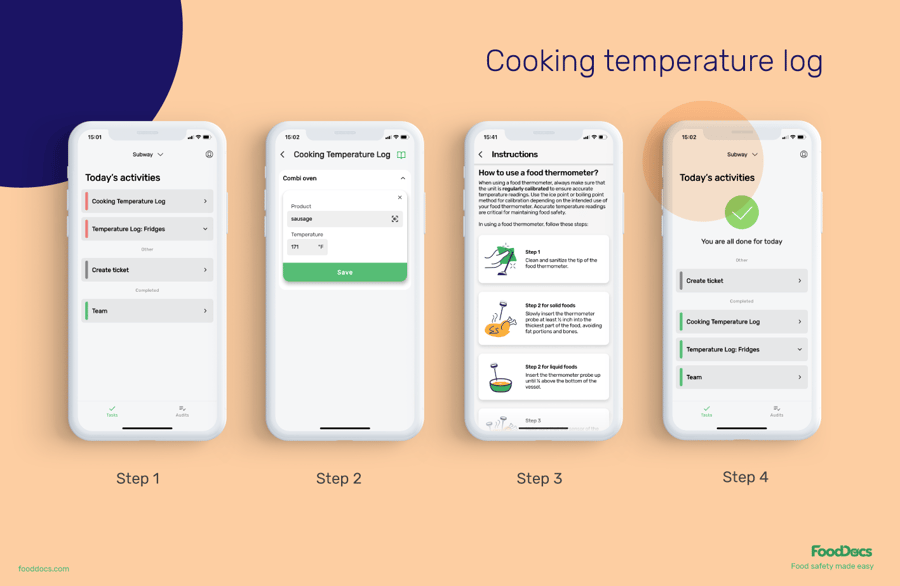
Cooking temperature log from FoodDocs
-
- Fridge temperature log
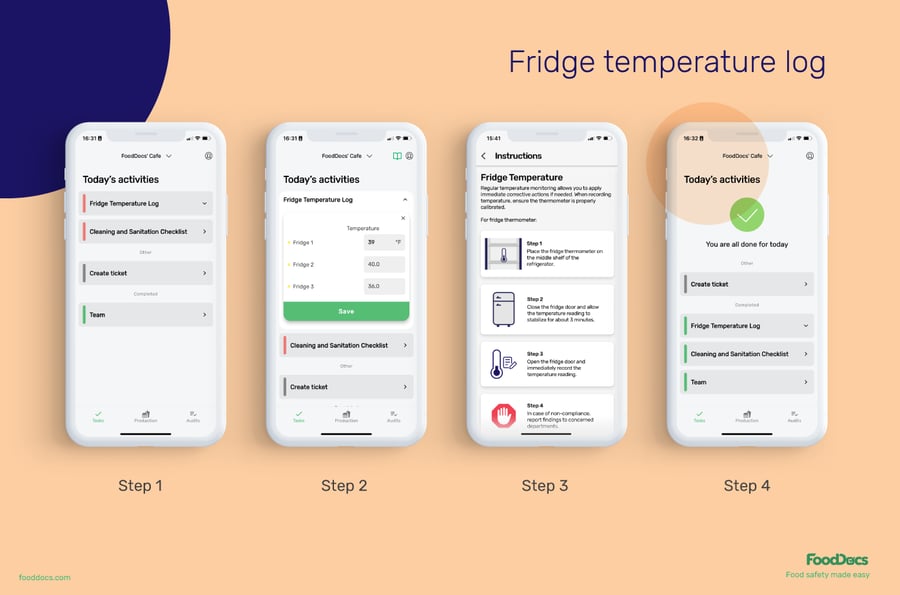
Fridge temperature log from FoodDocs
-
- Employee hygiene checklist
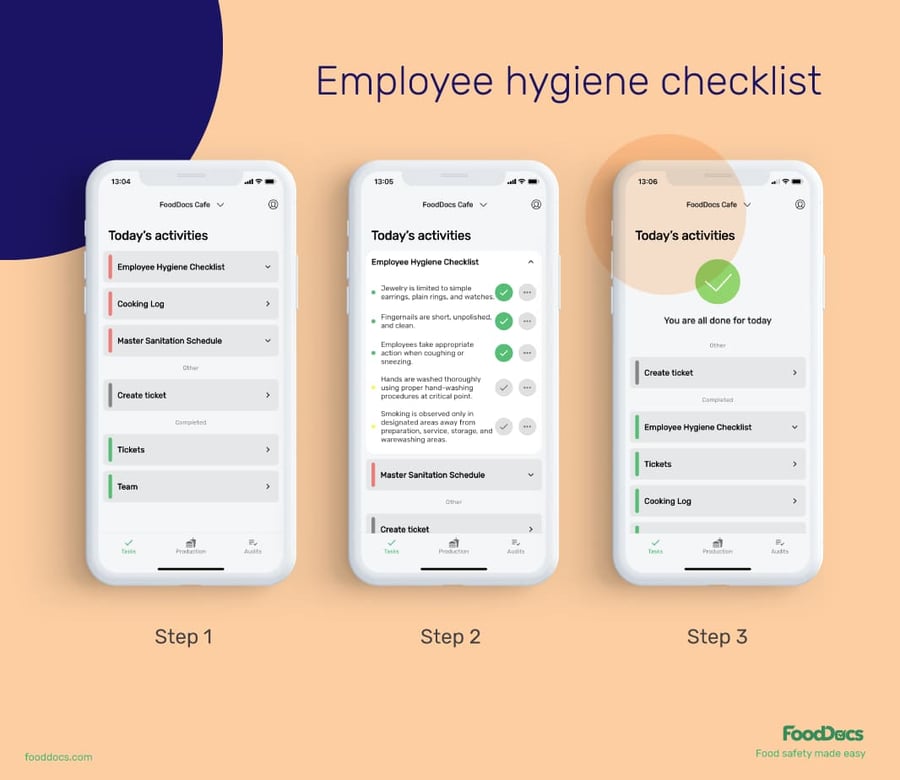
Employee hygiene checklist from FoodDocs
- Our software features smart notifications that can alert food handlers regarding any food safety task that needs to be done. With this feature, you can ensure that all of your operations are done on time and correctly.
Improve your efficiency in managing your food safety operations with the help of our smart software. Use the following features to manage your team better:
- Manage your production stocks from receiving materials up to shipping of finished goods using our Production Management System. Prevent stock-ous and keep track of your product's movement all the time.
- Get a real-time dashboard that shows you a quick overview of your operations across your branches. Using this feature, you can quickly determine areas that need more attention. Save at least 20% of your time from supervising your team on-site.
- Store and manage all digital documents in the cloud storage dedicated to your team. Pull out records in seconds whenever an inspector requests for it.
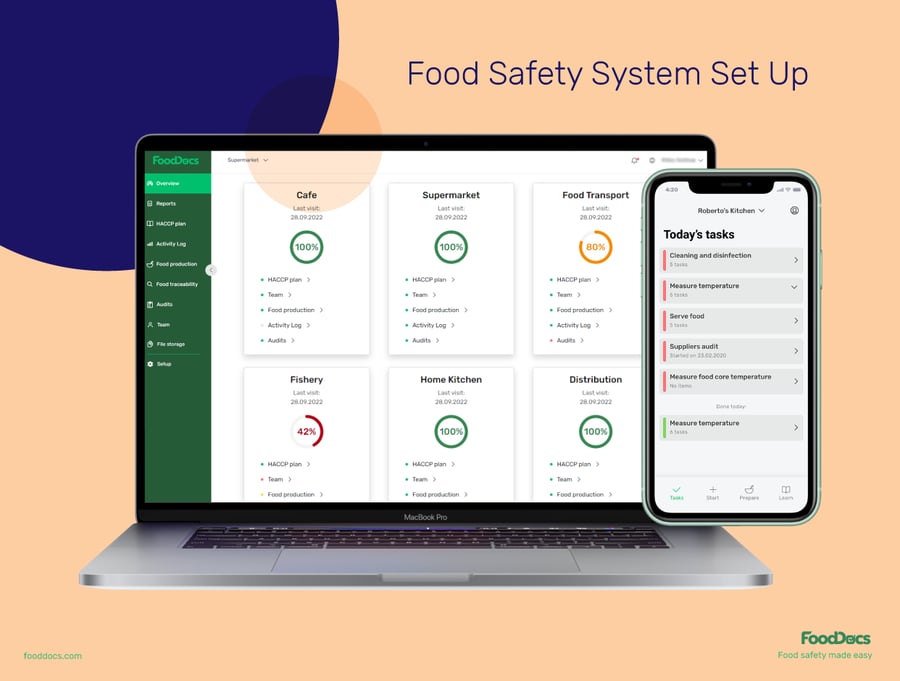
Food Safety System Set Up by FoodDocs
Get the most out of every food ingredient that you have by ensuring food safety compliance using our smart software. Consistently maintain compliance with food safety standards while building a better strategy to improve your food optimization.
Our system can also accommodate personalization. Customize the automatically generated monitoring logs according to your business needs. Quickly apply improvements suggested by inspectors and maintain compliance efficiently.
Start your digital food safety system journey now with our free 14-day trial.
Frequently Asked Questions
Do you still have a few more questions about keeping leftovers in the fridge? Below are some frequently asked questions about this topic.
How long can cooked food stay in the fridge?
Cooked foods can be refrigerated for a maximum of 4 days and remain safe for consumption. Food safety agencies, including the Food and Drug Administration and the USDA Food Safety and Inspection Service endorse this recommendation.
How long are restaurant leftovers good for?
When proper storage tips are followed, restaurant leftovers can last for up to 3 to four days in the refrigerator and up to 3-4 months in the freezer.
Is 7 days too long for leftovers?
Yes. Cold leftovers can still spoil as the growth of microorganisms is only slowed down.
What is the standard rule for storing leftovers?
All leftovers must be handled properly. Handlers must place them in airtight storage containers. The container of leftovers must be placed at the bottom of the refrigerator shelf to prevent potential cross-contamination.
How do you know if leftovers are too old?
Bad leftovers will often have an unpleasant smell or discoloration. These are tell-tale signs that the leftover is no longer safe for consumption.
How long can you eat leftover chicken?
If properly refrigerated, leftover chicken breast meat can remain safe for up to 3-4 days. This also applies to other poultry meat, such as leftover turkey. Make sure to properly reheat the chicken before serving.
